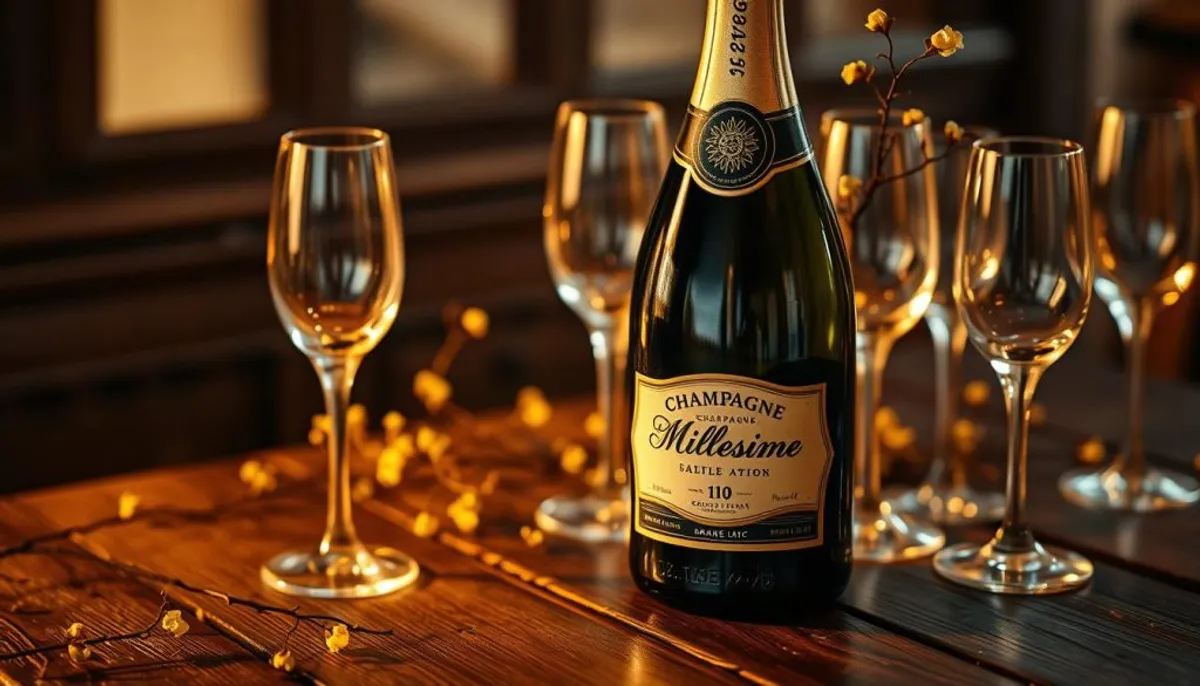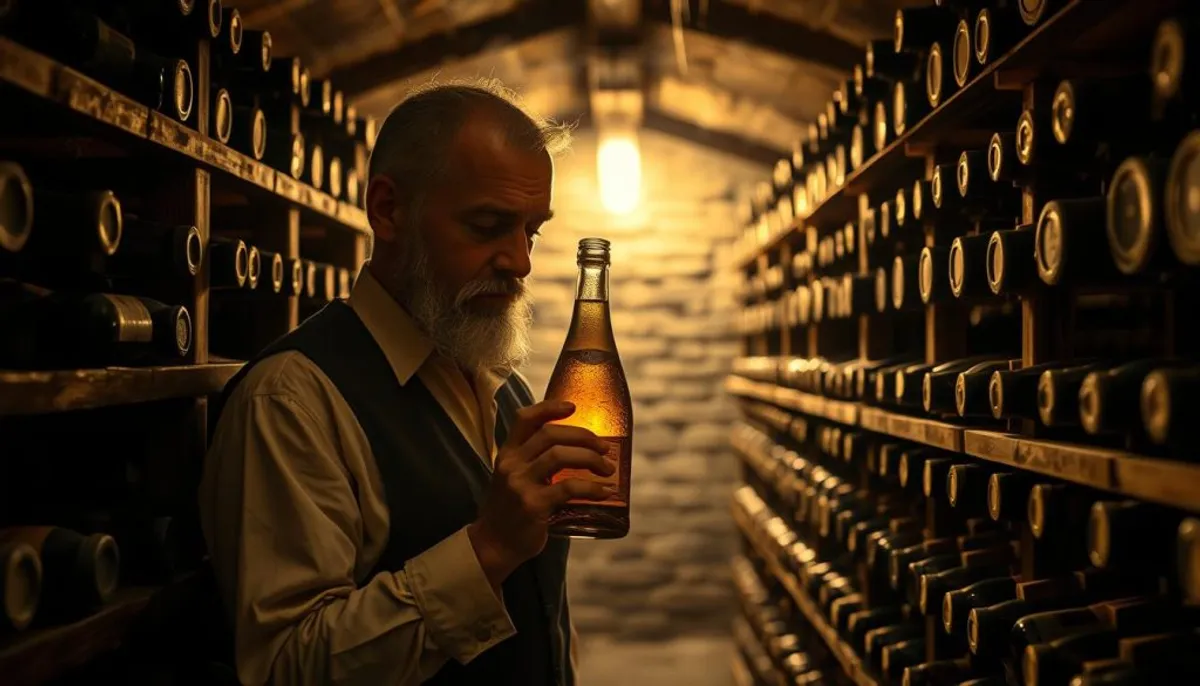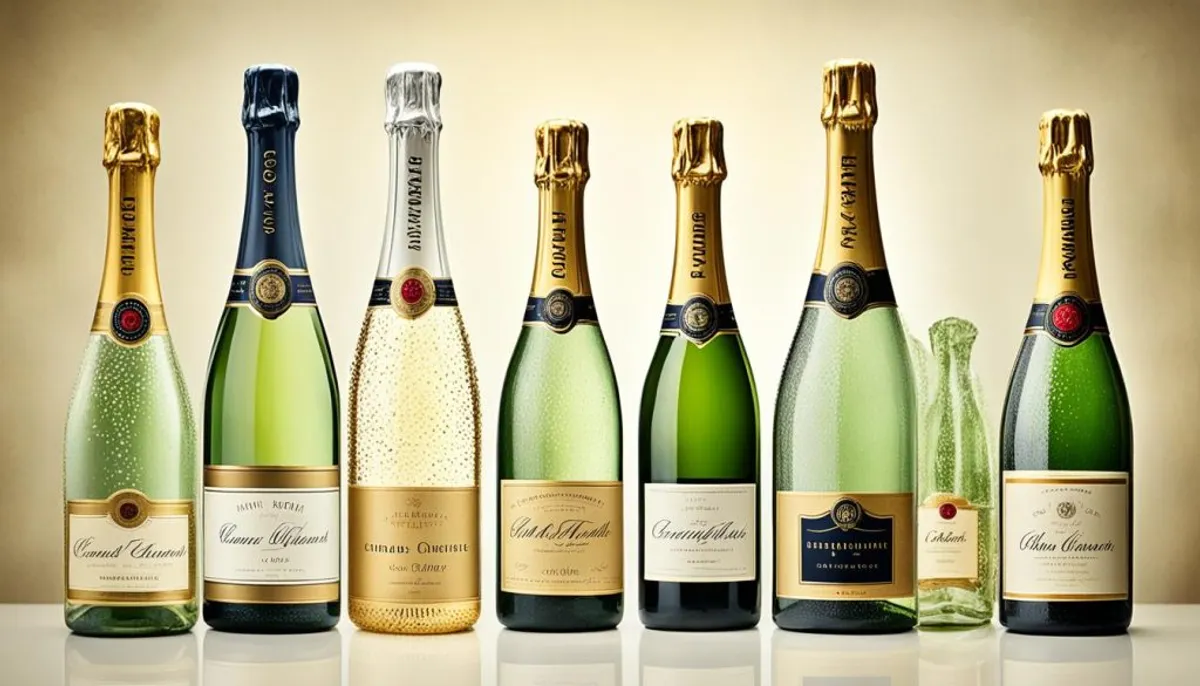Step into the world of Champagne Millesime, where luxury bubbles and French craftsmanship blend to create an unforgettable experience. This exclusive bubbly represents the crème de la crème of sparkling wines. It is produced only in years when nature bestows its finest gifts upon the vineyards of Champagne.
Unlike its non-vintage counterparts, vintage champagne captures the essence of a single extraordinary harvest. The French term “millésimé” hints at the dedication poured into each bottle. These precious wines must age for at least 1,000 days before gracing our glasses.

Champagne enthusiasts treasure these rare vintages for their unique character and ability to tell the story of a specific year. With only 1.3% of Champagne shipments being vintage in 2018, these bottles truly embody exclusivity in the world of fine wines.
Key Takeaways
- Champagne Millesime represents the pinnacle of luxury sparkling wines
- Vintage champagne reflects a single exceptional harvest year
- These wines must age for at least 36 months before release
- Vintage champagne shipments account for only 1.3% of total Champagne exports
- Each vintage tells a unique story of its harvest year
Understanding Vintage Champagne’s Unique Character
Vintage champagne is a standout in the sparkling wine world. Its distinctiveness comes from a blend of factors that shape its production and quality. Let’s explore what makes vintage champagne so unique.
The Art of Single-Year Production
Vintage champagne is a reflection of exceptional harvest conditions. Unlike standard champagne, which blends wines from various years, vintage production focuses on grapes from a single outstanding year. This approach showcases the unique traits of that specific growing season. It results in a champagne that embodies a particular moment in time, much like the contributions of female vintners who bring their unique perspectives and expertise to the craft.
Minimum Aging Requirements
The aging process is vital in enhancing champagne quality. Vintage champagnes must age for at least three years, with many producers extending this to five years or more. This extended aging period allows the wine to develop complex flavors and aromas. These nuances distinguish it from non-vintage champagnes.
Weather’s Impact on Vintage Quality
Weather conditions significantly affect vintage champagne quality. Ideal conditions include long growing seasons with warm, clear skies. These factors enhance the complexity of both Pinot Noir and Chardonnay grapes used in champagne production. Interestingly, great vintages often arise from moderate to hot years, rather than cool ones.
| Factor | Impact on Vintage Champagne |
|---|---|
| Production Method | Single-year grape harvest |
| Minimum Aging | 3 years (often 5+ years) |
| Ideal Weather | Long growing season, warm harvest |
| Key Grape Varieties | Pinot Noir and Chardonnay |
The rarity of vintage champagne enhances its appeal. For example, Charles Mignon produced only 7,500 bottles of their Cuvée Comte de Marne Brut Grand Cru Millésimé 2012. This highlights the exclusivity of these exceptional vintages, which are often found in auction houses for champagne.
What Makes Champagne Millesime Special
Champagne Millesime is a rare gem, epitomizing the pinnacle of luxury wine. It accounts for only 1.3% of all champagne exports, positioning it as a coveted collector’s item. Each bottle embodies the distinct essence of a single harvest year, showcasing the champagne’s singular character in every taste.
The creation of Millesime champagne is a reflection of exceptional climatic conditions. Cellar masters meticulously assess each year’s harvest, determining if it meets the stringent criteria for a vintage release. This rigorous selection guarantees that only the most superior years are designated as Millesime, elevating its stature in the luxury wine realm.
The aging process of Champagne Millesime further accentuates its uniqueness. For instance, the Mazet domaine ensures their NV cuvées rest on lees for at least six years, fostering intricate flavors. Their 2015 “Millésime” Champagne, comprising 45% Pinot Meunier, 30% Chardonnay, and 25% Pinot Noir, is aged in 225-liter French oak casks. This showcases the craftsmanship behind each bottle.
The rarity of Millesime Champagne extends beyond its limited production to its irreplaceable nature. Each vintage narrates the tale of a specific year’s climate and terroir, rendering every bottle a unique representation of time and geography. This singular quality, combined with its scarcity, cements Champagne Millesime’s reputation as a highly coveted luxury wine.
The Evolution of Vintage Champagne Through Decades
Vintage champagne boasts a storied history, with some houses producing for up to 200 years. These rare gems constitute only 1-5% of all champagne, underscoring their rarity in the world of wine collecting. Exploring the vintage years offers a glimpse into the champagne’s history and the craftsmanship behind each bottle.
Standout Years of the 1980s
The 1980s were marked by exceptional vintages in champagne production. Notably, 1985 and 1988 were declared as outstanding years, with a significant number of vintage declarations. These years highlighted the decade’s capability to produce unforgettable champagnes.
Notable Vintages from the 1990s
The 1990s also left an indelible mark on champagne history. The 1996 vintage, in particular, is renowned for its perfection, earning a flawless 10/10 rating. This decade underscored the pivotal role of vintage years in defining the champagne industry. Notably, the dom perignon 1973 vintage is often celebrated for its unique characteristics and exquisite taste, adding to the legacy of this remarkable era.
21st Century Excellence
The 21st century introduced its own champions to the champagne world. The 2002 vintage received widespread acclaim, with ratings ranging from 4 to 5 stars. It is regarded as one of the finest years since 1996, known for its complexity, richness, and firm acidity. The 2008 vintage, on the other hand, surprised many with its perfect 5-star rating, solidifying its status as a timeless classic.
| Decade | Notable Vintages | Characteristics |
|---|---|---|
| 1980s | 1985, 1988 | High percentage of vintage declarations |
| 1990s | 1996 | Legendary, perfect 10/10 rating |
| 2000s | 2002, 2008 | Complexity, richness, firm acidity |
Grasping the nuances of these vintage years is essential for both champagne enthusiasts and collectors. Each decade adds its distinct flavor to the evolving tapestry of vintage champagne. This journey through time is a captivating exploration of taste and quality, especially when considering the variety of brunch drinks that complement these exquisite selections.
Climate and Terroir: The Foundation of Excellence
The champagne region is a mosaic of micro-vineyards, each adding to the vintage champagnes’ exceptional quality. Spanning 34,000 hectares across 319 communes, it includes 280,000 individual plots. Here, French vineyards flourish on slopes, planted with Chardonnay, Pinot Noir, and Meunier grapes.
Soil composition is pivotal in champagne production. The region’s limestone subsoil offers ideal growing conditions. Famous crayères dug into the chalk around Reims provide excellent drainage. This chalky foundation imparts distinct mineral notes to the wines, enriching their character.
The microclimate of the champagne region is characterized by cool temperatures and adequate rainfall. This is perfect for cultivating the primary grape varieties. The unique climate, combined with the soil composition, creates an ideal environment for producing exceptional champagnes.
| Aspect | Details |
|---|---|
| Total Vineyard Area | 34,000 hectares |
| Number of Communes | 319 |
| Individual Plots | 280,000 |
| Main Grape Varieties | Chardonnay, Pinot Noir, Meunier |
| Soil Type | Limestone with chalk subsoil |
Champagne winemaking prioritizes sustainable soil management. It reduces herbicide use, opting for cover cropping and in-row tillage instead. This approach preserves the terroir and enhances grape quality. It ultimately contributes to the excellence of vintage champagnes.
The Role of Grape Varieties in Vintage Expression
Vintage champagne embodies the essence of a single harvest year. The choice of grape varieties is pivotal in defining the wine’s flavor and aging capacity. We will examine how various grape varieties contribute to the creation of outstanding vintage champagnes.
Pinot Noir’s Contribution
Pinot Noir is a cornerstone in champagne blending. It imparts body, structure, and red fruit nuances to the wine. In vintage champagnes, the ruinart r signature blend enriches the complexity and depth, elevating the overall taste.
Chardonnay’s Influence
Chardonnay grapes introduce elegance, acidity, and floral elements to vintage champagnes. They contribute a fresh, crisp character that counterbalances Pinot Noir’s richness. For instance, in Mumm Millésimé 2013, Chardonnay from Cramant and Avize enhances the wine’s floral aromas.
Perfect Balance in Blending
The art of champagne blending hinges on achieving a perfect equilibrium between grape varieties. Expert cellar masters meticulously blend Pinot Noir and Chardonnay, along with the exquisite ruinart r signature blend, to forge harmonious vintage champagnes. These champagnes mirror the distinct traits of a single harvest year.
| Grape Variety | Contribution to Vintage Champagne |
|---|---|
| Pinot Noir | Body, structure, red fruit flavors, complexity |
| Chardonnay | Elegance, acidity, floral notes, freshness |
The synergy of these grape varieties yields vintage champagnes with extraordinary depth and aging potential. Mumm Millésimé 2013 exemplifies this, with its butter, brioche, and vanilla notes from aging. It maintains a refined balance between Chardonnay’s floral nuances and Pinot Noir’s yellow fruit flavors.
Cellar Masters: The Architects of Vintage
Cellar masters are the unsung heroes of champagne production. Their winemaking expertise shapes the character of each vintage. These skilled professionals blend art and science to craft exceptional bottles that captivate wine enthusiasts worldwide.
Vintage selection is a critical aspect of a cellar master’s role. They carefully evaluate each year’s harvest, deciding whether to declare a vintage based on the quality and potential of the grapes. This decision requires extensive knowledge of terroir, climate conditions, and grape varieties.

Blending skills are at the heart of champagne creation. Cellar masters meticulously combine wines from different vineyards and vintages to achieve the desired flavor profile. Their refined palates and olfactory memory guide them in creating consistent non-vintage champagnes and exceptional vintage releases.
The importance of cellar masters is evident in the industry’s recognition of their talents. For example, Séverin Frerson made history as the first female cellar master at Maison Perrier-Jouët in its 200-year legacy. Her appointment highlights the evolving nature of champagne production and the growing diversity in this prestigious field.
Cellar masters oversee the aging process, which can span several years. At Abelé 1757 Champagne House, the Brut and Blanc de Blancs cuvées age for 3-4 years in chalk cellars over 150 years old. These underground chambers, spanning nearly two kilometers, maintain ideal conditions for champagne maturation.
The impact of cellar masters extends beyond production. They play a crucial role in preserving champagne heritage and innovation. The Vinothèque at Abelé 1757, housing vintages from the 1920s, serves as a testament to their enduring legacy in champagne production.
Tasting Notes and Aromatic Profiles
Wine tasting is an art that uncovers the true essence of vintage Champagne. The flavor profile of premium vintages showcases the mastery of winemaking and the unique characteristics of each year. Understanding how to identify exceptional vintages and their aging potential is crucial.
Identifying Premium Vintages
Premium vintage Champagnes are distinguished by their complex flavors and aromas. For instance, Charles Heidsieck’s 2013 Brut Millésimé, a blend of 57% Pinot Noir and 43% Chardonnay, exemplifies balance despite challenging weather. The 2012 vintage, with 60% Pinot Noir and 40% Chardonnay, showcases resilience, producing quality despite a 30% reduced yield.
Development of Complex Flavors
Aroma development in vintage Champagne is a captivating process. The Millésime 2008, composed of 60% Pinot Noir and 40% Chardonnay, exhibits minerality, intensity, and acidity. This vintage benefited from cold weather during flowering and a mild winter, resulting in healthy, ripe grapes at harvest.
Aging Potential Indicators
Vintage quality is often measured by aging potential. The 2006 vintage, with 59% Pinot Noir and 41% Chardonnay, offers excellent cellaring potential after aging in ancient chalk Crayères for over a decade. Rare Millésime 2013, a blend of 70% Chardonnay and 30% Pinot Noir, undergoes full malolactic fermentation and ages on lees for at least 8 years, followed by cork aging for a minimum of 1 year.
| Vintage | Blend | Characteristics |
|---|---|---|
| 2013 | 57% Pinot Noir, 43% Chardonnay | Harmonious despite challenging weather |
| 2012 | 60% Pinot Noir, 40% Chardonnay | Excellent quality, reduced yield |
| 2008 | 60% Pinot Noir, 40% Chardonnay | Minerality, intensity, acidity |
| 2006 | 59% Pinot Noir, 41% Chardonnay | Excellent cellaring potential |
Investment Value of Vintage Champagne
Vintage champagne emerges as a top contender for wine investment. These rare vintages constitute only a small portion of champagne production, with 10-20% being vintage releases. This scarcity significantly boosts their value in the luxury collectibles market, and many collectors turn to auction houses for champagne to acquire these prized bottles.
The champagne market has witnessed significant growth, with vintage releases leading the charge. For instance, Jacques Selosse’s Grand Cru Millesime, with a limited production of 4,000 bottles per vintage, has demonstrated substantial returns. Since July 2020, the 2009, 2007, and 2005 vintages have appreciated by 240%, 240%, and 267% respectively.
Exceptional vintages from renowned houses command high prices. The 1995 Krug Clos d’ Ambonnay Blanc de Noirs Brut, for example, fetches $3,626. The 1921 Pol Roger Vintage Brut is valued at $3,441. These figures highlight the investment potential of premium vintage champagnes.
Several factors influence the investment value of vintage champagne. These include the champagne house’s reputation, the vintage’s quality, and the condition of storage. Investors should prioritize highly rated vintages from top producers to enhance their returns. With champagne sales on the rise and the Chinese market expected to double by 2026, vintage champagne remains a compelling choice for diversifying investment portfolios with luxury collectibles.
Modern Vintage Selection Guide
Champagne collecting is an art that demands both knowledge and precision. This vintage guide aims to assist you in navigating the realm of fine bubbles. It focuses on identifying the best years for collection, the importance of proper wine storage, and the role of female vintners in enhancing the quality and diversity of the wines, as well as the optimal times for consumption.
Best Years for Collection
In curating your champagne collection, prioritize exceptional vintages. The 2008 vintage is a standout, earning 99 points from Robert Parker. Years like 2012 and 2013 also shine, offering superior aging potential. These vintages are highly sought after and worth the effort to acquire.

Storage Recommendations
Ensuring the right storage conditions is vital for preserving your vintage champagne. Store bottles horizontally in a cool, dark environment with consistent humidity levels. Aim for a temperature of around 55°F for optimal aging. Avoid drastic temperature changes and excessive light to preserve the wine’s quality.
When to Drink
The perfect moment to open your vintage champagne is a matter of personal taste and the specific wine’s characteristics. Many vintage champagnes reach their zenith after 10-30 years. Younger vintages present fresh, lively flavors, while aged bottles develop richer, more complex notes. Trust your taste and enjoy the exploration of each vintage’s unique profile.
| Vintage | Parker Score | Peak Drinking Window |
|---|---|---|
| 2008 | 99 | 2023-2048 |
| 2012 | 96 | 2022-2042 |
| 2013 | 95 | 2023-2043 |
Conclusion
Champagne Millesime represents the zenith of luxury in the realm of fine dining. It embodies the pinnacle of wine expertise, offering aficionados an unparalleled tasting experience. The 2014 and 2015 vintages, in particular, exemplify the intricate nuances of champagne appreciation.
In blind tastings, the 2014 vintage marginally surpassed 2015, scoring 90.3 to 90.2. Notwithstanding, the 2015 vintage dominated the top ten rankings with six wines. Brands like Ruinart Millésime 2015 and Taittinger Brut Millésime 2014 consistently impressed, showcasing the artistry behind these vintages.
The production of Millesime champagne is a testament to the meticulous wine expertise. From manual harvesting involving 120,000 seasonal workers to the precise fermentation process lasting 7-10 days, every step contributes to its distinct character. The extended aging period of up to 3 years for vintage champagnes results in a complexity that elevates the luxury experience of each sip.
RelatedRelated articles



